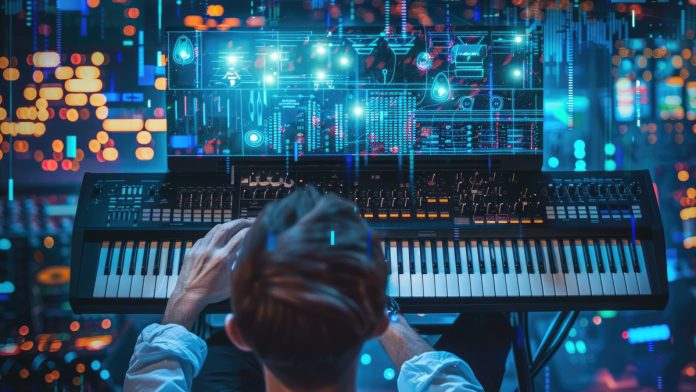Today, the advent of Artificial Intelligence in DAWs is reshaping music production, paving the way for enhanced audio design, streamlined workflows, and innovative creative possibilities. This integration of computational power with artistic intuition not only revolutionizes sound crafting but also democratizes high-level production, empowering musicians, and producers to explore new dimensions of audio expression.
| Table of Contents | |
|---|---|
| I. | Adaptive Audio Analysis and Signal Processing |
| II. | Machine Learning-Driven Sound Synthesis |
| III. | Generative Composition and Algorithmic Music Generation |
| IV. | Automated Mixing and Mastering Assistance |
| V. | Intelligent Plugin Orchestration and DAW Integration |
| VI. | Predictive Workflow Optimization and Personalized Production Suggestions |
| VII. | Real-Time Performance Feedback and Adaptive Editing |
| VIII. | Enhanced Audio Restoration and Noise Reduction |
| IX. | AI-Assisted Orchestration and Arrangement |
| X. | Ethical Considerations and Creative Ownership |
Adaptive Audio Analysis and Signal Processing
Modern digital audio workstations now incorporate advanced tools for adaptive audio analysis and signal processing. These methods dynamically interpret sonic textures and frequency content, enabling precise adjustments during tracking or post-production. By breaking down audio signals into quantifiable components, engineers can enhance clarity and creative manipulation. This analytical approach supports informed decision-making when filtering, compressing, or equalizing sounds in a digital landscape.
Machine Learning-Driven Sound Synthesis
Innovative sound synthesis techniques leverage machine learning algorithms that learn and evolve based on input data. This approach refines timbres, predicts harmonic structures, and tailors unique sonic qualities with minimal manual tweaking. For instance, a system might generate textures that complement a vocal track automatically, echoing the ethos of Artificial Intelligence in DAWs. Such technology not only saves valuable studio time but also opens fresh avenues for sonic experimentation.
Generative Composition and Algorithmic Music Generation
Algorithmic music generation now allows software to assist in crafting melodic structures, chord progressions, and rhythmical patterns autonomously. By employing generative processes, producers can explore experimental compositions and unexpected arrangements. These systems analyze established music patterns and generate new ideas that challenge conventional composition while still providing a robust foundation for further creative refinement. This fusion of computation and creative insight is redefining traditional music composition.
Automated Mixing and Mastering Assistance
Digital mixing and mastering are increasingly supported by automated systems capable of balancing levels, panning, and frequency distributions. These intelligent tools analyze tracks in real time, suggesting or applying corrections to optimize overall sound quality. With precise control over dynamics and spatial imaging, automated mixing and mastering assistance ensures consistently polished results. Such smart systems relieve producers from repetitive tasks, letting them focus on creative decision-making throughout the production process.
Intelligent Plugin Orchestration and DAW Integration
Seamless integration of plugins within DAWs now offers intelligent orchestration of sound effects and virtual instruments. Systems automatically load, adjust, and arrange plugins based on the project’s context, embodying the innovative spirit of Artificial Intelligence in DAWs. This orchestration simplifies complex signal routing and effect chaining while maintaining creative flexibility. By reducing manual configuration, producers can experiment freely and optimize their workflow for both studio sessions and live performances.
Predictive Workflow Optimization and Personalized Production Suggestions
Emerging technologies in digital audio environments analyze user habits and project histories to provide predictive workflow enhancements. These systems learn preferences and frequently used techniques, suggesting optimizations that streamline production processes. By offering personalized guidance, producers can anticipate creative needs, reduce technical interruptions, and maintain artistic momentum. This smart, context-aware assistance acts as a virtual mentor, subtly steering projects toward improved efficiency without overshadowing the artist’s unique vision.
Real-Time Performance Feedback and Adaptive Editing
Integrating real-time performance feedback tools into DAWs allows musicians to receive immediate insights during live recording or editing sessions. These systems monitor performance metrics and track deviations, offering adaptive editing suggestions and adjustments on the fly. Such immediate response capabilities help refine timing, tuning, and dynamic expression as the performance unfolds. This proactive approach to editing accelerates the recording process and enhances artistic expression through instantaneous corrective feedback.
Enhanced Audio Restoration and Noise Reduction
Advanced algorithms now excel at discerning and removing unwanted noise from audio recordings. Through detailed spectral analysis, these tools can isolate and reduce ambient hiss or interference while preserving musical integrity. This process not only revitalizes archival recordings and live sessions but also ensures that every detail of a mix is rendered with pristine clarity. Enhanced restoration and noise reduction empower producers to elevate sound quality and maintain a high standard of production fidelity.
AI-Assisted Orchestration and Arrangement
Innovative orchestration tools in modern DAWs analyze and suggest arrangement modifications based on the underlying structure of a composition. By offering automated counter-melodies, harmonization, or rhythmic enhancements, these systems serve as creative collaborators. They help balance traditional musical sensibilities with modern production techniques, embodying the promise of Artificial Intelligence in DAWs to merge technology with artistic craft. This collaboration encourages experimentation and supports a more fluid, intuitive arrangement process.
Ethical Considerations and Creative Ownership
As AI-driven tools become integral to music production, ethical questions surrounding creative ownership and data usage emerge. Balancing technology’s role with human creativity is critical in preserving artistic integrity and ensuring fair recognition. Producers and technologists are actively exploring intellectual property frameworks, transparency measures, and consent protocols. These discussions ensure that while automation drives efficiency and innovation, the human element remains central to the art of music, safeguarding cultural expression and individual artistry.

